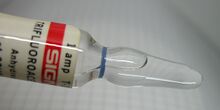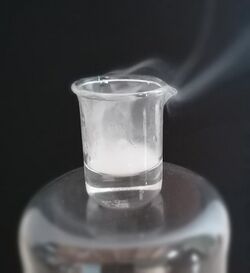Chemistry:Trifluoroacetic acid
| |||

| |||

| |||
| Names | |||
|---|---|---|---|
| Preferred IUPAC name
Trifluoroacetic acid | |||
| Other names
2,2,2-Trifluoroacetic acid
2,2,2-Trifluoroethanoic acid Perfluoroacetic acid Trifluoroethanoic acid TFA | |||
| Identifiers | |||
3D model (JSmol)
|
|||
| 742035 | |||
| ChEBI | |||
| ChEMBL | |||
| ChemSpider | |||
| 2729 | |||
PubChem CID
|
|||
| RTECS number |
| ||
| UNII | |||
| |||
| |||
| Properties | |||
| C2HF3O2 | |||
| Molar mass | 114.023 g·mol−1 | ||
| Appearance | colorless liquid | ||
| Odor | Pungent/Vinegar | ||
| Density | 1.489 g/cm3, 20 °C | ||
| Melting point | −15.4 °C (4.3 °F; 257.8 K) | ||
| Boiling point | 72.4 °C (162.3 °F; 345.5 K) | ||
| miscible | |||
| Vapor pressure | 0.0117 bar (1.17 kPa) at 20 °C[1] | ||
| Acidity (pKa) | 0.52 [2] | ||
| Conjugate base | trifluoroacetate | ||
| -43.3·10−6 cm3/mol | |||
| Hazards | |||
| Main hazards | Highly corrosive | ||
| Safety data sheet | External MSDS | ||
| GHS pictograms |  
| ||
| GHS Signal word | Danger | ||
| H314, H332, H412 | |||
| P260, P261, P264, P271, P273, P280, P301+330+331, P303+361+353, P304+312, P304+340, P305+351+338, P310, P312, P321, P363, P405, P501 | |||
| NFPA 704 (fire diamond) | |||
| Related compounds | |||
Related perfluorinated acids
|
Heptafluorobutyric acid Perfluorooctanoic acid Perfluorononanoic acid | ||
Related compounds
|
Acetic acid Trichloroacetic acid | ||
Except where otherwise noted, data are given for materials in their standard state (at 25 °C [77 °F], 100 kPa). | |||
| Infobox references | |||
Trifluoroacetic acid (TFA) is an organofluorine compound with the chemical formula CF3CO2H. It is a structural analogue of acetic acid with all three of the acetyl group's hydrogen atoms replaced by fluorine atoms and is a colorless liquid with a vinegar-like odor.

TFA is a stronger acid than acetic acid, having an acid ionisation constant, Ka, that is approximately 34,000 times higher,[3] as the highly electronegative fluorine atoms and consequent electron-withdrawing nature of the trifluoromethyl group weakens the oxygen-hydrogen bond (allowing for greater acidity) and stabilises the anionic conjugate base. TFA is widely used in organic chemistry for various purposes.
Synthesis
TFA is prepared industrially by the electrofluorination of acetyl chloride or acetic anhydride, followed by hydrolysis of the resulting trifluoroacetyl fluoride:[4]
- CH3COCl + 4 HF → CF3COF + 3 H2 + HCl
- CF3COF + H2O → CF3COOH + HF
Where desired, this compound may be dried by addition of trifluoroacetic anhydride.[5]
An older route to TFA proceeds via the oxidation of 1,1,1-trifluoro-2,3,3-trichloropropene with potassium permanganate. The trifluorotrichloropropene can be prepared by Swarts fluorination of hexachloropropene.
Uses
TFA is the precursor to many other fluorinated compounds such as trifluoroacetic anhydride, trifluoroperacetic acid, and 2,2,2-trifluoroethanol.[4] It is a reagent used in organic synthesis because of a combination of convenient properties: volatility, solubility in organic solvents, and its strength as an acid.[6] TFA is also less oxidizing than sulfuric acid but more readily available in anhydrous form than many other acids. One complication to its use is that TFA forms an azeotrope with water (b. p. 105 °C).
TFA is popularly used as a strong acid to remove protecting groups such as Fmoc and BOC used in organic chemistry and peptide synthesis.[7][8]
At a low concentration, TFA is used as an ion pairing agent in liquid chromatography (HPLC) of organic compounds, particularly peptides and small proteins. TFA is a versatile solvent for NMR spectroscopy (for materials stable in acid). It is also used as a calibrant in mass spectrometry.[9]
TFA is used to produce trifluoroacetate salts.[10]
Safety
Trifluoroacetic acid is a corrosive acid but it does not pose the hazards associated with hydrofluoric acid because the carbon-fluorine bond is not labile. TFA is harmful when inhaled, causes severe skin burns and is toxic for aquatic organisms even at low concentrations.
TFA's reaction with bases and metals, especially light metals, is strongly exothermic. The reaction with lithium aluminium hydride (LAH) results in an explosion.[11]
TFA is a metabolic breakdown product of the volatile anaesthetic agent halothane. It is thought to be responsible for halothane induced hepatitis.[12]
Environment
Sea water contains about 200 ng of TFA per liter.[13][14][15][16]
In the environment, it may be formed by photooxidation of the commonly used refrigerant 1,1,1,2-tetrafluoroethane (R-134a).[citation needed] Moreover, it is formed as an atmospheric degradation product of almost all fourth-generation synthetic refrigerants, also called hydrofluoroolefins (HFO), such as 2,3,3,3-tetrafluoropropene.[citation needed]
TFA is virtually non-degradable (persistent) in the environment. Median concentrations of a few micrograms per liter have been found in beer and tea.[17]
See also
- Fluoroacetic acid – highly toxic but naturally occurring rodenticide CH2FCOOH
- Difluoroacetic acid
- Trichloroacetic acid, the chlorinated analog
References
- ↑ Kreglewski, A. (1962). Trifluoroacetic acid. 10. pp. 629–633. https://webbook.nist.gov/cgi/cbook.cgi?ID=C76051&Mask=4&Type=ANTOINE&Plot=on. Retrieved 2020-03-01.
- ↑ CRC Handbook of Chemistry and Physics. 2016–2017. pp. 954–963. ISBN 978-1-4987-5429-3.
- ↑ Note: Calculated from the ratio of the Ka values for TFA (pKa = 0.23) and acetic acid (pKa = 4.76)
- ↑ 4.0 4.1 G. Siegemund; W. Schwertfeger; A. Feiring; B. Smart; F. Behr; H. Vogel; B. McKusick. "Ullmann's Encyclopedia of Industrial Chemistry". Ullmann's Encyclopedia of Industrial Chemistry. Weinheim: Wiley-VCH. doi:10.1002/14356007.a11_349.
- ↑ Wilfred L.F. Armarego; Christina Li Lin Chai (2009). "Chapter 4 - Purification of Organic Chemicals". Purification of Laboratory Chemicals (6th ed.). pp. 88–444. doi:10.1016/B978-1-85617-567-8.50012-3. ISBN 9781856175678.
- ↑ Eidman, K. F.; Nichols, P. J. (2004). L. Paquette. ed. Encyclopedia of Reagents for Organic Synthesis. New York: J. Wiley & Sons. doi:10.1002/047084289X.rt236.pub2. ISBN 9780471936237.
- ↑ Lundt, Behrend F.; Johansen, Nils L.; Vølund, Aage; Markussen, Jan (1978). "Removal of t-Butyl and t-Butoxycarbonyl Protecting Groups with Trifluoroacetic acid". International Journal of Peptide and Protein Research 12 (5): 258–268. doi:10.1111/j.1399-3011.1978.tb02896.x. PMID 744685.
- ↑ Andrew B. Hughes (2011). "1. Protection Reactions". Amino Acids, Peptides and Proteins in Organic Chemistry: Protection Reactions, Medicinal Chemistry, Combinatorial Synthesis. 4. pp. 1–97. doi:10.1002/9783527631827.ch1. ISBN 9783527631827.
- ↑ Stout, Steven J.; Dacunha, Adrian R. (1989). "Tuning and calibration in thermospray liquid chromatography/mass spectrometry using trifluoroacetic acid cluster ions". Analytical Chemistry 61 (18): 2126. doi:10.1021/ac00193a027.
- ↑ O. Castano; A. Cavallaro; A. Palau; J. C. Gonzalez; M. Rossell; T. Puig; F. Sandiumenge; N. Mestres et al. (2003). "High quality YBa2Cu3O7 thin films grown by trifluoroacetates metal-organic deposition". Superconductor Science and Technology 16 (1): 45–53. doi:10.1088/0953-2048/16/1/309. Bibcode: 2003SuScT..16...45C.
- ↑ Safety data sheet for Trifluoroacetic acid (PDF) from EMD Millipore, revision date 10/27/2014.
- ↑ "Halothane", LiverTox: Clinical and Research Information on Drug-Induced Liver Injury (Bethesda (MD): National Institute of Diabetes and Digestive and Kidney Diseases), 2012, PMID 31643481, http://www.ncbi.nlm.nih.gov/books/NBK548151/, retrieved 2021-07-15
- ↑ Frank, H.; Christoph, E. H.; Holm-Hansen, O.; Bullister, J. L. (January 2002). "Trifluoroacetate in ocean waters". Environ. Sci. Technol. 36 (1): 12–5. doi:10.1021/es0221659. PMID 11811478. Bibcode: 2002EnST...36...12P.
- ↑ Scott, B. F.; MacDonald, R. W.; Kannan, K.; Fisk, A.; Witter, A.; Yamashita, N.; Durham, L.; Spencer, C. et al. (September 2005). "Trifluoroacetate profiles in the Arctic, Atlantic, and Pacific Oceans". Environ. Sci. Technol. 39 (17): 6555–60. doi:10.1021/es047975u. PMID 16190212. Bibcode: 2005EnST...39.6555S.
- ↑ Frank, Hartmut; Christoph, Eugen H.; Holm-Hansen, Osmund; Bullister, John L. (2002). "Trifluoroacetate in Ocean Waters". Environmental Science & Technology 36 (1): 12–15. doi:10.1021/es0101532. ISSN 0013-936X. PMID 11811478. Bibcode: 2002EnST...36...12F.
- ↑ Joudan, Shira; De Silva, Amila O.; Young, Cora J. (2021). "Insufficient evidence for the existence of natural trifluoroacetic acid" (in en). Environmental Science: Processes & Impacts 23 (11): 1641–1649. doi:10.1039/D1EM00306B. ISSN 2050-7887. http://xlink.rsc.org/?DOI=D1EM00306B.
- ↑ Marco Scheurer, Karsten Nödler (2021). "Ultrashort-chain perfluoroalkyl substance trifluoroacetate (TFA) in beer and tea – An unintended aqueous extraction". Food Chemistry 351: 129304. doi:10.1016/j.foodchem.2021.129304. ISSN 0308-8146. PMID 33657499.
 |



